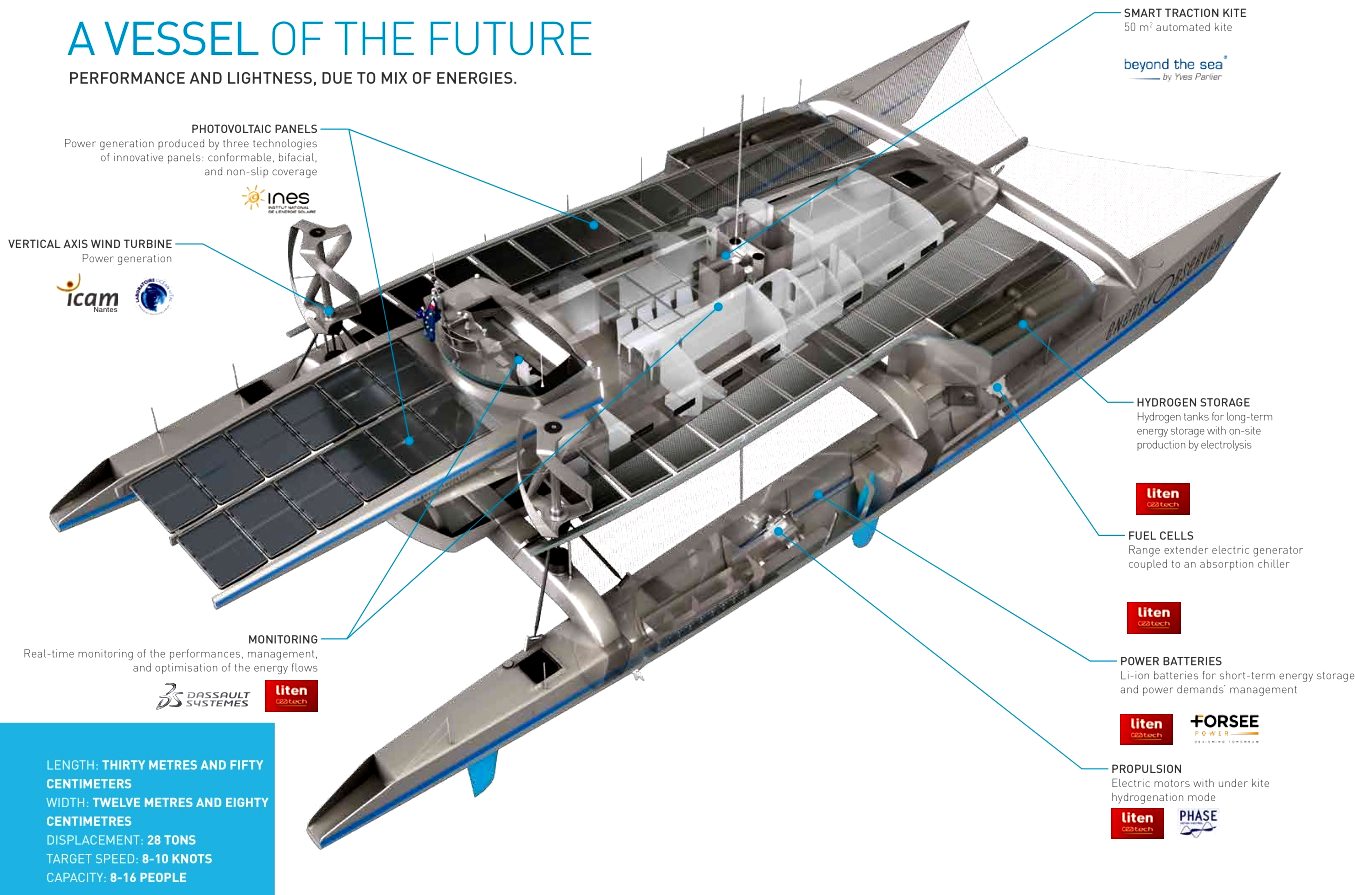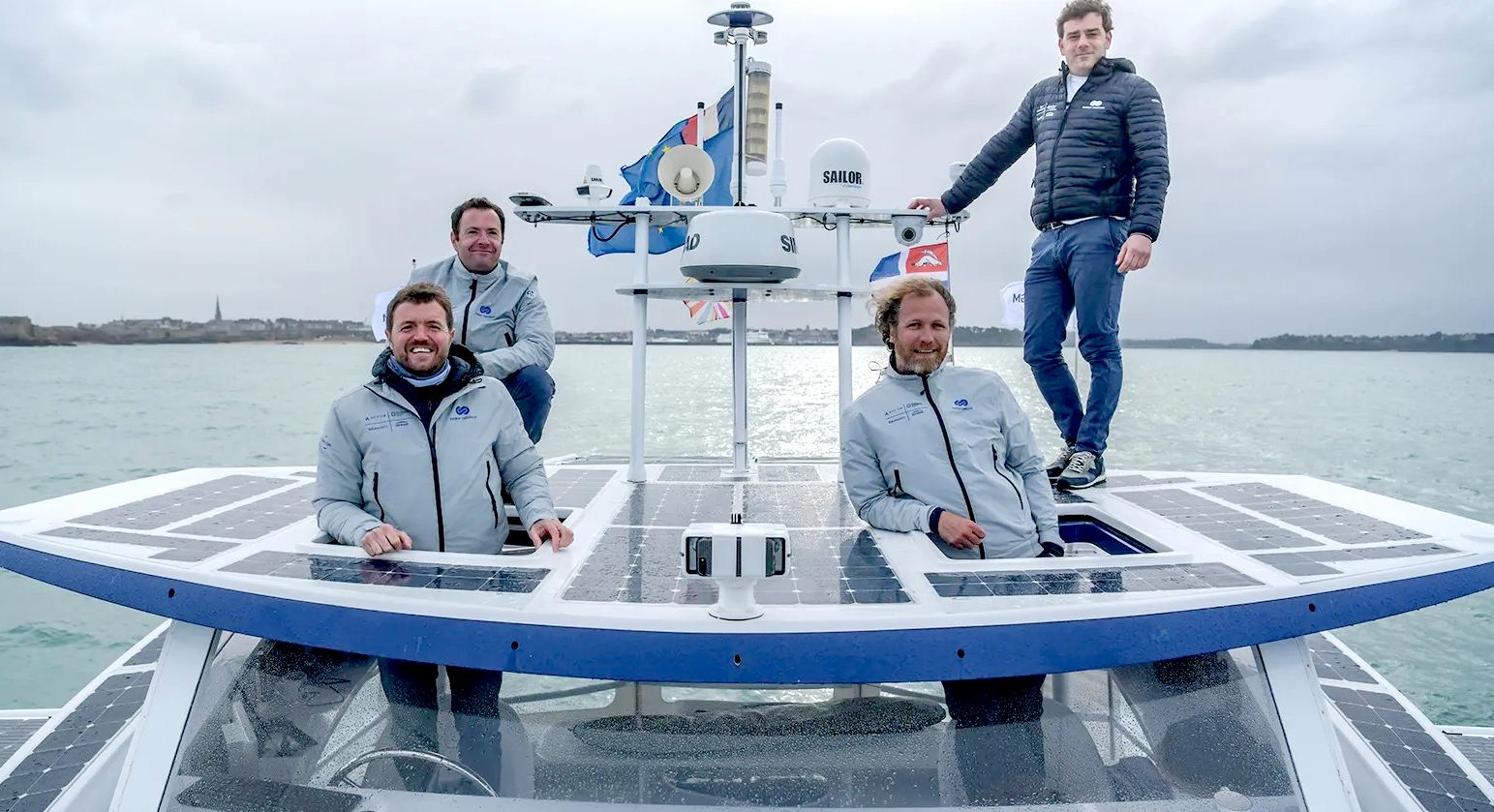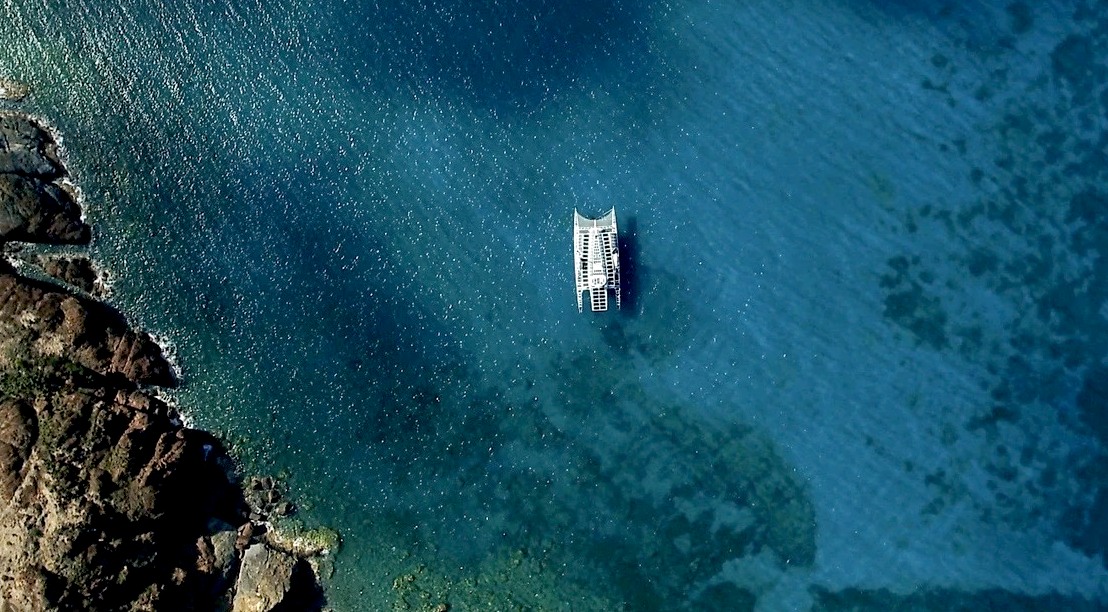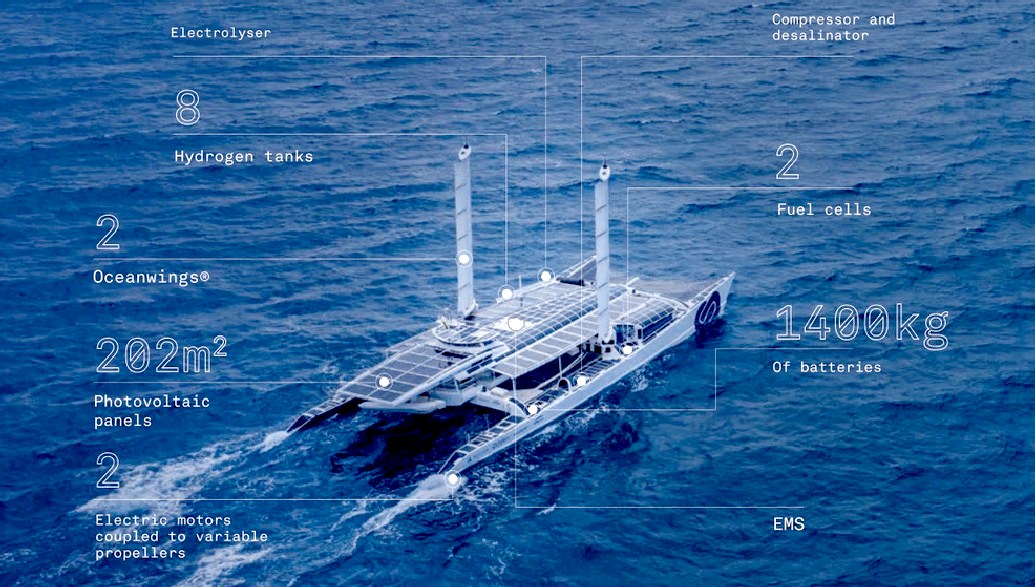
GREEN
HYDROGEN - A hydrolyzer and fuel cell energy storage combination. In 2017, the first
hydrogen-fueled "marine" fuel cell was installed in France on board Energy Observer, for a series of stopovers, in France, then in Europe, thus leading our autonomous ship to the Arctic Circle in 2019. During this trip, Energy Observer was equipped with a
fuel
cell, developing a power of 30kW, designed in collaboration with the CEA. Although it is still on board and has fulfilled its role wonderfully during these first couple of years, the energy needs of the ship kept increasing as new technologies were installed to be tested and as the
navigation periods extended.
FORBES
6 JULY 2021 - A HYDROGEN POWERED BOAT IS SAILING THE WORLD. IF NOT IN CARS, DO BOATS MAKE SENSE?
Recently the French originated demonstration boat the Energy Observer stopped for a visit to San Francisco, on its way around the world, having come from the Galapagos and on its way to Hawai`i. The boat uses solar power, hydrogen and battery energy storage and a small amount of high-tech wind.
On board are 200 square meters of solar panels, 1500kg of batteries, tanks for 63kg of
hydrogen (good for 1MWH of
electricity and another 1MWH of heat) along with electric motors, solid computer-controlled “ocean wing” sails and a desalinator and
hydrogen generator to refuel the hydrogen tanks. It travels only 5mph without wind, though can do more — and even regenerate electricity — when the winds get strong enough.
Using renewable wind power to move ships is of course a very ancient technique, and it’s well understood and efficient. Sailing ships have issues when becalmed, and in sailing in narrow channels, but otherwise it’s not clear this ship is a better idea than a sailboat with a small motor system. It is more to demonstrate and play with technologies, and the operators are reluctant to give concrete numbers on costs. That’s unfortunate because any story about energy is vastly reduced in meaning without examination of the economics — even if it’s the future promised economics rather than today’s. Indeed, inattention to economics has led to some really stupid renewable energy projects and even some very stupid laws. Nonetheless, the ship is a cool project, even if it doesn’t deliver information as meaningful as it should.
Hydrogen is a controversial energy storage fuel. It’s not an energy source, but rather a competitor for things like lithium batteries. Many had high hopes for it in cars, but for now it has lost the battle to batteries.
Toyota sells the
Mirai hydrogen vehicle in very small numbers, but with only a few filling stations available, and the hydrogen coming from fossil fuels, it’s not clear why anybody buys one. Hydrogen’s advantages such as weight and refuel time (when
there aren’t any
stations) aren’t very powerful in a car compared to its disadvantages — higher cost for fuel and fuel cells, offering less than 50% efficiency, having
no refueling
infrastructure, non-green sourcing, bulky tanks and much more. Some of those can be fixed, but others are difficult.
This has left us to investigate hydrogen in other areas — large vehicles like
trucks and
buses, aircraft (where weight is hugely important) and now, ships. There is also research on
grid
storage, though the low efficiency of conversion is a sticking point. The greatest promise is in aircraft. Hydrogen is actually the best fuel around in terms of energy per kg, but at present storing a kg of hydrogen requires 5 to 12kg of tank, which eliminates a lot of that — but even at that poor ratio it still wins in aircraft.
In a ship, the Energy Observer crew believe that batteries would weigh more than 10 tons. While they don’t say the weight of their H2 system, it probably is more in the range of a ton. Weight is not quite as crucial for ships but that much extra weight comes at a cost. In addition, the EO reduces the waste of fuel cells by making use of the excess heat to provide heat on the ship. Normally the total cycle of hydrogen as storage is less than 50% efficient, which is not good when batteries can deliver 90% or more. Heat though, is certainly needed for a passenger vessel at sea. A cargo vessel might not need so much.
The ship uses up the H2 in operation when there is no wind. The H2 recharges the batteries and provides heat, then the batteries run all systems. With enough wind, the
solar panels can instead recharge the batteries and make new H2 using desalinated
water and electrolysis. Their goal is to not use any net H2 on a typical day, but if winds and sun are poor, they will use it up, but plan their missions to leave with enough H2 to handle such situations. While docked, the panels and shore power build up the H2, or in theory, they might some day find H2 refilling at a “hydrogen marina.” When they left for Hawai`i from San Francisco, they only filled the H2 tank partially because they did not need it all the way full.
The ship used to be a racing catamaran, but instead of sails it has two “ocean wing” fixed-shape sails. These solid wings can generate as much thrust as cloth sails twice their size. They are small, to not block the sun, but they are also computer controlled, allowing them to be used without much crew effort or requiring any skill. When the wind is really strong, the propellers and motors can spin in reverse to generate
electricity to build up more H2. Full sized sails would do better though, and could be put up at night with no risk of blocking the sun. They seem to have shied away from traditional sail and wind power in spite of their well established value. Before they had the ocean wings, they tried installing wind turbines, which failed for obvious reasons.
Life on board is spartan. The catamaran’s cabin is small for a crew of 8. Also on board is a small science sub-crew taking the opportunity to study the oceans and wildlife on such an unusual voyage.
A ship has the space for H2 tanks and the ability to generate it, so this can make sense. I don’t think a future vessel would look like the Energy Observer, but hybrids of electric drive and traditional sail, adding what
solar power can be had make sense. Every inch of the deck is solar panels, and there are even panels to get the sunlight reflecting off the water. As panels get cheap this makes sense, though you don’t want to forgo useful sails because of the shade they will cast if the wind will give you more than the sun.
It’s possible to foresee solar/wind/electric recreational boats. Operating recreational boats is highly polluting and expensive. Sailboats are clean and cheap but a lot of work and under many limitations. A hybrid, using electric power, could be an answer there, as well as an answer for the big
cargo
ships.
WHAT NEXT FOR HYDROGEN?
Hydrogen may not power cars, but it has some chance at other vehicles that want to avoid burning fossil fuel:
Aircraft care immensely about weight. Batteries today can give only modest range to
electric
aircraft. It’s either H2 or synthetic/biofuel hybrid power trains there.
One special type of aircraft is quite interesting, the airship. While people have been scared of H2 there since the
Hindenberg, it’s important to realize that H2 can be more than a lift gas, it can be the power fuel. It’s the only fuel that has negative weight, and you don’t need to pressurize it with big heavy tanks in an airship.
Trucks are looking at H2 because the battery weight for a truck takes up a large part of their 40 ton limit, and trucks have a harder time stopping for long enough to charge it. The 50% energy loss is trouble, but the weight limit is a legal requirement.
Grid storage with over 50% loss is a serious problem. But with H2, if you want more capacity, you just need more tanks. Doubling the tanks doesn’t double the cost, but doubling batteries does double the cost.
Other types of energy storage are not standing still, though. There are experiments with newer batteries, flywheels, aluminum, synthetic hydrocarbon fuels and more underway. It’s a space ripe for change.
By Brad Templeton

FICTION - A
version of the Energy Observer features in 'Kulo-Luna,'
the story of a giant humpback whale that fights against whalers of a
future world where ocean plastic has made fish so toxic, that whaling
has become legal again to feed starving fishing nations.
SUN WIND HYDROPOWER
When
launched in April 2017, the Observer claims to be the first vessel in the world to both generate and be powered by hydrogen. She was developed in collaboration with engineers from the CEA-LITEN.
The boat produced and stores hydrogen using desalinated seawater thanks to an energy mix involving: 3 types of solar panels spreading over a surface
(originally) of 130 square meters (21 kW peak), 2 vertical axis wind turbines (2 x 1 kW), 1 traction kite and 2 reversible electric motors (2x41 kW) of hydrogenation, 1 lithium battery (106 kWh), 1
desalinator, 1 electrolyser, 1 compressor, 1 fuel cell (22 kW), and 62 kg of hydrogen. The complete hydrogen system weighs 2100 kilos.
These
specifications have since been changed along with lengthening of the
hulls. Recently, 36.8m² of solar panel area have been added to the existing 165m² for 5.6Kw of additional power and a total surface area of 202m². As a result, the maximum power will be 34kWp
(they have almost doubled the power since 2017) but the Observer does
not have sun tracking as with the Elizabeth Swann, and the Swann has
55kW, with room for expansion. Much more harvesting area, but then the
Swann was designed from the waves up to be solar powered. The Observer
has a power to weight ratio of 1.14 kW/ton. More than PlanetSolar's
1.05kW/ton, but nowhere near the 3kW/ton potential of the Elizabeth
Swann.

Energy Observer
development continued in the winter of 2017 with a series of tests at sea before its big departure from Saint-Malo in the
spring of 2018. It was scheduled to call in at Paris for a first event where the boat
would be officially christened, with her new name. This event celebrated the start of a
planned six-year expedition, scheduled from 2017 to 2022, visiting 50 countries and 101 ports of call including: historical ports, wildlife sanctuaries, natural reserves, endangered ecosystems, and international events.

Victorien Erussard, offshore racer and merchant naval officer,
leads the expedition, along with Jérôme Delafosse, professional diver and producer of wildlife documentaries.
Energy Observer is a former race boat that has been reconditioned: Built
in Canada in 1983 by naval architect Nigel
Irens, under the supervision
of sailor Mike Birch. The 'maxi-multihull' marked the evolution of its successors. Baptised Formule
TAG, presumably after the Swiss watch company, it was the first racing sailboat to break the symbolic 500 miles limit in 24 hours in 1984.

The boat has
been lengthened four times and now displays the following dimensions:
Length 30,5 metres (100ft)
Width 12,80 metres
Weight 30 metric tons
Speed 8-10 knots
CONTACTS
Vincent Caumes
- Press Relations
media@energy-observer.org
+33 (0)6 08 51 42 53
Joséphine Guinard
- Press agent
media@energy-observer.org
+33 (0)7 86 43 79 91
For
questions related to the Odyssey: contact@energy-observer.org
For questions related to the Innovations: contact.eodev@energy-observer.org
https://www.forbes.com/sites/bradtempleton/2021/07/06/a-hydrogen-powered-boat-is-sailing-the-world--if-not-in-cars-do-boats-make-sense/
https://www.energy-observer.org/

LATEST
ADVANCES & UPGRADES
The transition from a 30kW battery to the new 80kW fuel cell (60kW continuous) has not only doubled the capacities of the vessel, it has increased them exponentially. Indeed, it is important to understand that a REXH2 is, like the
Toyota Mirai, designed to operate in conjunction with one or more batteries. Although it is theoretically possible to ensure the propulsion of a small boat, having a simple and recurrent user profile, with the electricity supplied by a single
fuel cell, it is more pragmatic to couple it with batteries which will serve both as an energy reserve (storage) and as an energy source for the propulsion and the hotel load.
The benefits, compared to an "all-electric" scheme, is to reduce the need for a large number of batteries, whose sustainability and recycling possibilities are questionable, while allowing a substantial weight gain for more or less the same volume. It is also a cheaper solution in terms of acquisition price / buying price and operational costs In addition, up to 10 REXH2 can be combined so as to bring the power of the system from 80 to 800kW. Finally, the hydrogen fueling it can be completely
"green", when resulting from water
electrolysis, whereas a battery is usually recharged via "the grid", whose energy is not always of virtuous origin.
In
their view, the REXH2, in electric hybridization, or even in diesel-hydrogen-electric hybridization, appears today as the option most likely to reduce as much as possible
CO2 and fine particle emissions on board ships, looking to the future improvement of green hydrogen production and storage capacities, when it may finally be possible to run fleets of ships on hydrogen to meet all of the on-board energy needs.
After spending many months on Toyota’s test bench in Belgium, in its test version, the first REXH2 was finally installed on board Energy Observer, where is was tested again and again over the winter to ensure its reliability as well as its performance in a demanding marine environment, subject to many changing weather patterns, waves, swell and roll.
Where
the ocean is a roller coaster, not a
highway, a fuel cell is a sensitive organ, which must be protected from any external dust and harmful particles. In February 2020
the REXH2 was ready to be implemented for its first transatlantic crossing, but was unfortunately delayed a few times as a result of capricious weather conditions across the
Atlantic, something the Mayflower
came up against in 2021.
The bet was all the more daring as the adventure was attempted with a new
fuel
cell, rather than simply relying on the capacities of the previous one, which would not have been enough to guarantee the autonomy required for such a crossing anyway, especially as the
Pacific crossing is also looming in the distance.

GREEN
HYDROGEN - The REXH2® fuel cell - compressor – inverter set, installed back in 2019, boasts a maximum power output of 60 kW (though it is operated at around 50% of its potential to optimize its output).
HISTORY
OF THE CRAFT
The slender bows of Formule TAG, now Energy Observer, remain the identifying feature of this famous ocean racer, but much else has changed during the boat’s many lives.
In 1983, the 80ft Formule TAG was launched as part of a revolutionary new generation of multihulls designed for ocean racing and record-breaking. At the time it was the largest ocean racing
catamaran of its type, built using aerospace technology. The following year it beat the 24-hour record by covering 512.5 miles.
In 1993 it was bought by Peter Blake and Robin Knox-Johnston for a Jules Verne attempt, famously flying a spinnaker decorated with bright red and green apples under the name ENZA (Eat New Zealand Apples). The second attempt, in 1994, succeeded and the boat set a round the world crewed record of 74 days.
Next, it became Royal & Sun Alliance, skippered by Tracy
Edwards. Although the Jules Verne Trophy proved elusive, Edwards and her team broke seven world records.

Then Tony Bullimore took it on, extending the hulls to 100ft and racing as Team Legato in the round the world race organised by Bruno Peyron to celebrate the year 2000: The Race.
In 2010, off Cape Finistère, it capsized in 15 knots of wind. Many thought the boat would never recover from such an accident: too old to race, too damaged to be repaired.
Enter French entrepreneur Victorien Erussard. He's sailed everything from Hobie cats and Formula 18s to competing in the Route du Rhum and Transat Jacques Vabre, had a different idea.
His aim was to build the first 100% energy self-sufficient vessel. The chassis of a former ocean-racing catamaran would make the ideal platform, and ‘recycling’ an existing boat fitted perfectly with the project’s ambitions.







